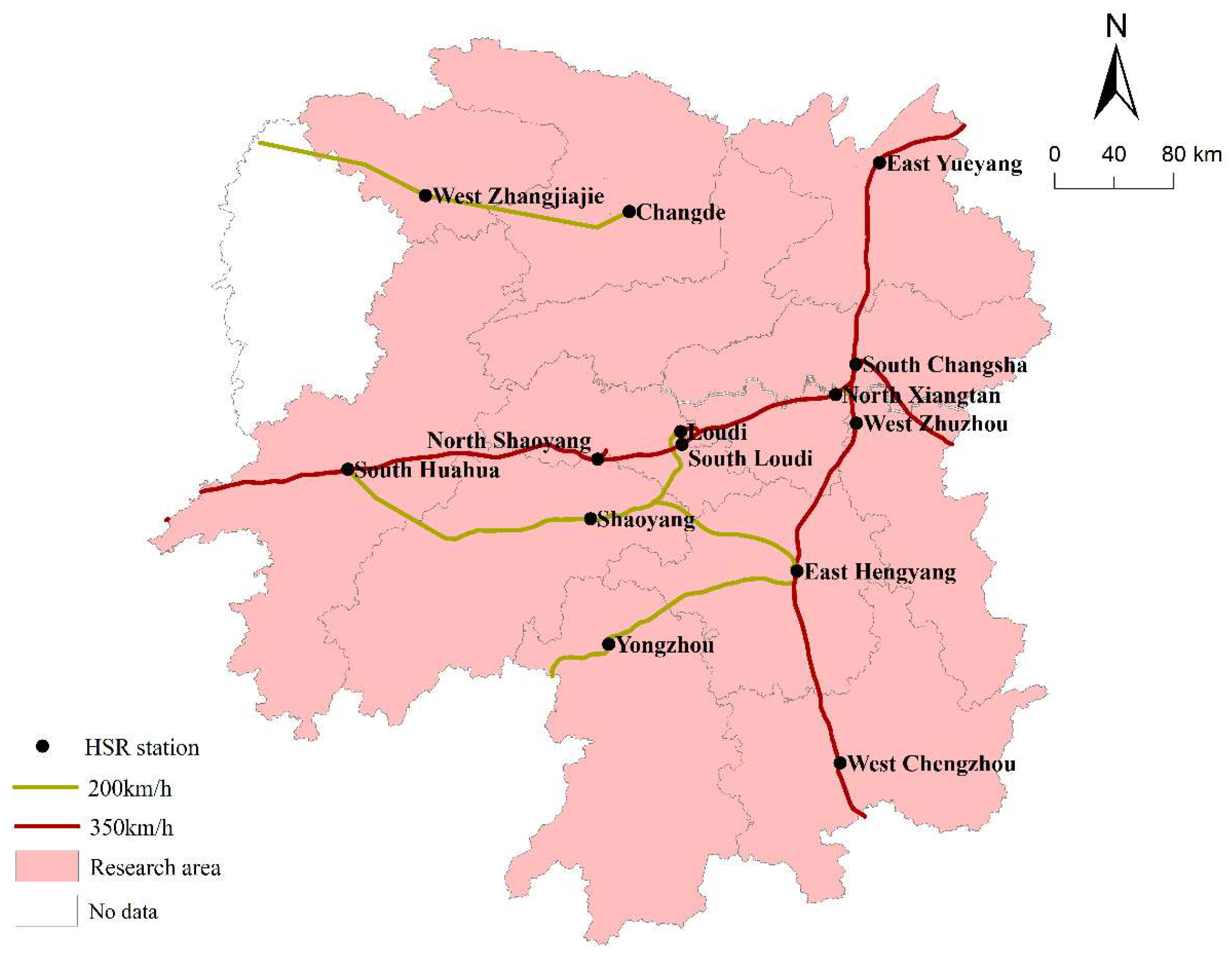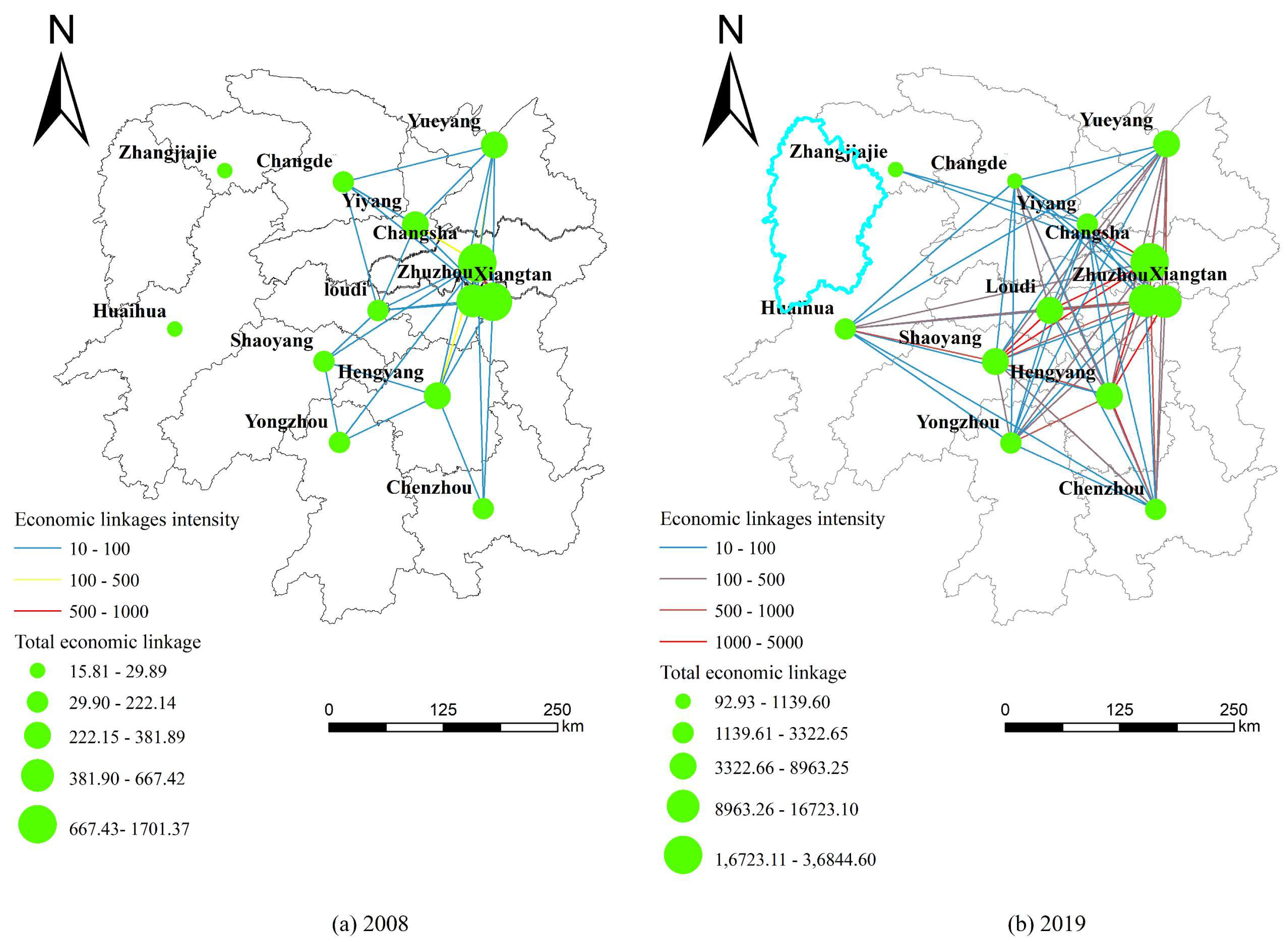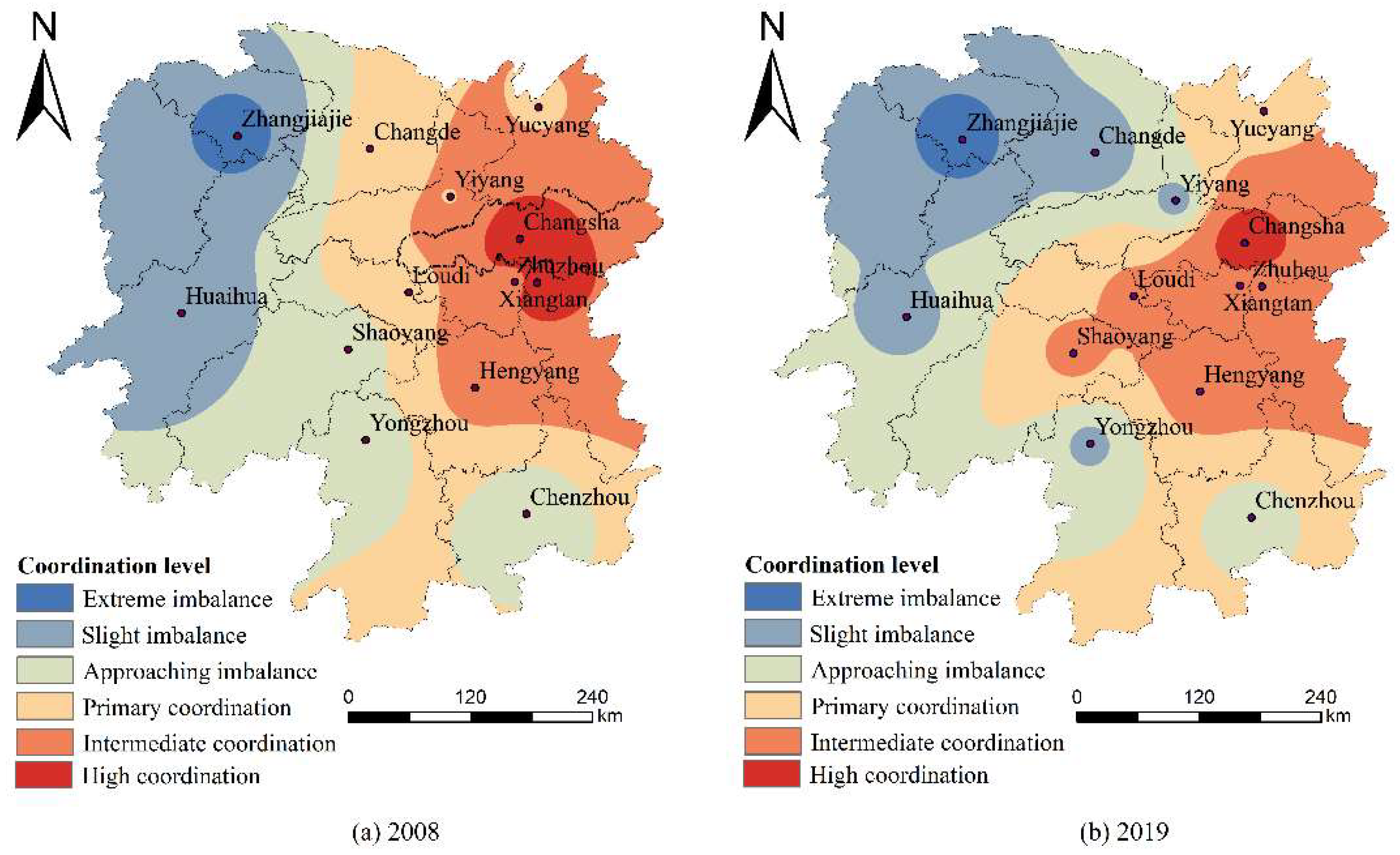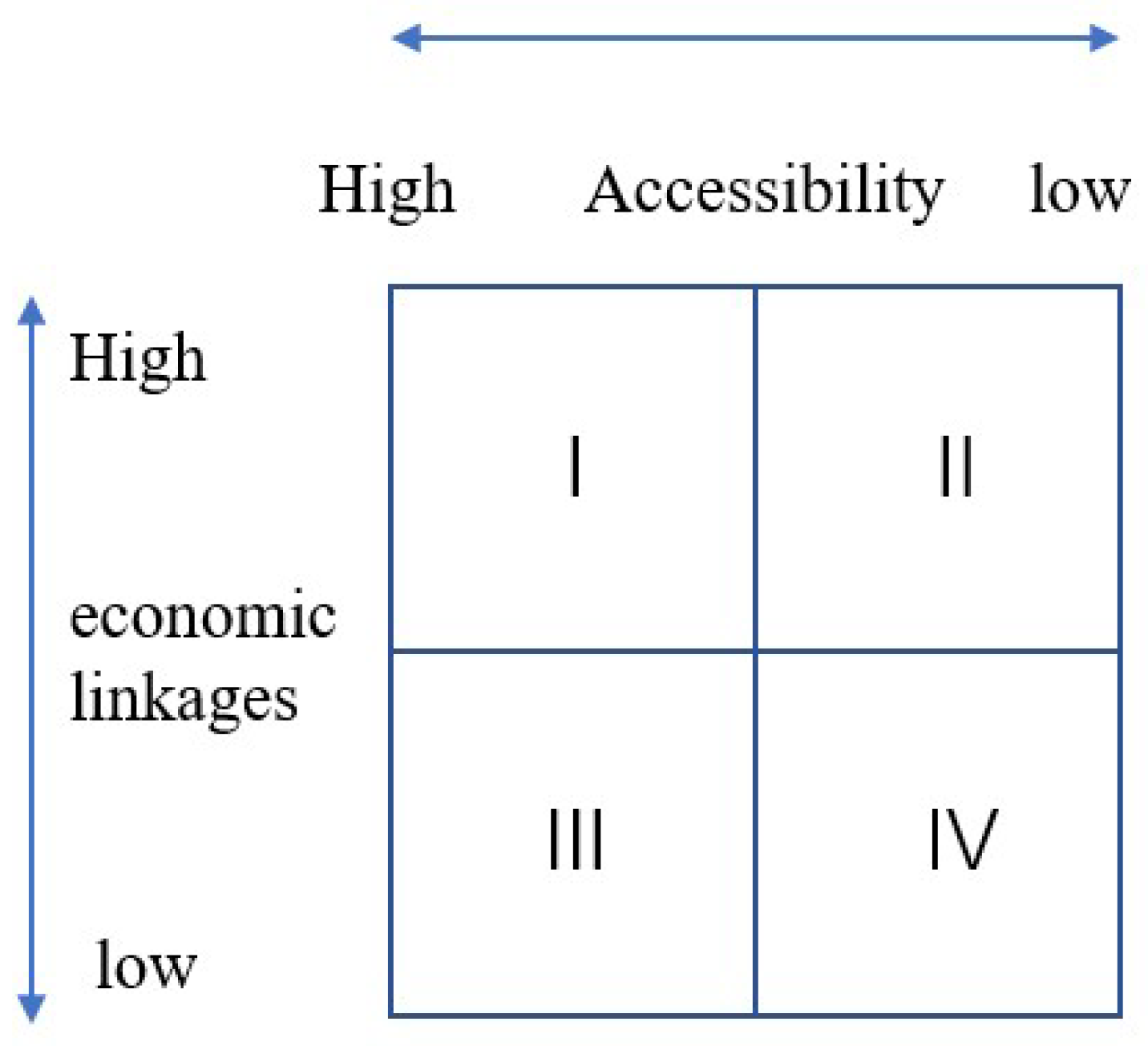Analysis of Coupling Coordination Relationship between the Accessibility and Economic Linkage of a High-Speed Railway Network Case Study in Hunan, China
Abstract
:1. Introduction
1.1. Accessibility
1.2. Economic Linkage
1.3. Coupled Coordination Model
2. Materials and Methods
2.1. Study Area
2.2. Data Sources
2.3. Research Methods
2.3.1. Weighted Average Travel Time
2.3.2. Economic Linkage Intensity
2.3.3. Coupled Coordination Model
3. Results
3.1. Spatial and Temporal Differences in Accessibility
3.2. Spatial Layout of Economic Linkage
3.3. Coupling Coordination Degree Analysis
4. Conclusions and Policy Implications
4.1. Conclusions
4.2. Policy Implications
Author Contributions
Funding
Institutional Review Board Statement
Informed Consent Statement
Data Availability Statement
Acknowledgments
Conflicts of Interest
References
- Oladele, A.S. Technological Advances and Sustainable Workforce Development through Enhanced Collaboration for Sustainability of Transport Infrastructure. In Proceedings of the ASCE International Conference on Transportation and Development (ASCE ICTD), Seattle, WA, USA, 26–29 May 2020; pp. 277–286. [Google Scholar]
- Pagliara, F.; Henke, I. The Impacts of High-Speed Rail on Territorial Accessibility: A Comparison Among Some European Countries. In Proceedings of the 21st International Conference on Computational Science and Its Applications (ICCSA), Cagliari, Italy, 13–16 September 2021; pp. 242–254. [Google Scholar]
- Kortazar, A.; Bueno, G.; Hoyos, D. Environmental balance of the high speed rail network in Spain: A Life Cycle Assessment approach. Res. Transp. Econ. 2021, 90, 101035. [Google Scholar] [CrossRef]
- Jiao, J.; Wang, J.; Jin, F.; Dunford, M. Impacts on accessibility of China’s present and future HSR network. J. Transp. Geogr. 2014, 40, 123–132. [Google Scholar] [CrossRef]
- Shaw, S.-L.; Fang, Z.; Lu, S.; Tao, R. Impacts of high speed rail on railroad network accessibility in China. J. Transp. Geogr. 2014, 40, 112–122. [Google Scholar] [CrossRef]
- An, Y.; Wei, Y.D.; Yuan, F.; Chen, W. Impacts of high-speed rails on urban networks and regional development: A study of the Yangtze River Delta, China. Int. J. Sustain. Transp. 2021, 16, 483–495. [Google Scholar] [CrossRef]
- Grujicic, I.; Raidl, G.; Schobel, A.; Besau, G. A Metaheuristic Approach for Integrated Timetable Based Design of Railway Infrastructure. In Proceedings of the 3rd International Conference on Road and Rail Infrastructure (CETRA), Split, Croatia, 28–30 April 2014; pp. 691–696. [Google Scholar]
- Sama, M.; D’Ariano, A.; Pacciarelli, D.; Corman, F. Lower and upper bound algorithms for the real-time train scheduling and routing problem in a railway network. In Proceedings of the 14th IFAC Symposium on Control in Transportation Systems (CTS), Istanbul, Turkey, 18–20 May 2016; pp. 215–220. [Google Scholar]
- Huang, Y.; Xu, W. Spatial and temporal heterogeneity of the impact of high-speed railway on urban economy: Empirical study of Chinese cities. J. Transp. Geogr. 2021, 91, 102972. [Google Scholar] [CrossRef]
- Jin, S.; Yang, J.; Wang, E.; Liu, J. The influence of high-speed rail on ice-snow tourism in northeastern China. Tour. Manag. 2020, 78, 104070. [Google Scholar] [CrossRef]
- Liu, G.G.; Tang, C.X.; Liu, Y.H.; Bu, T.; Tang, D.S. Will high-speed railway influence the healthcare seeking behaviour of patients? Quasi-experimental evidence from China. Health Policy Plan 2021, 36, 1633–1643. [Google Scholar] [CrossRef]
- Li, Q.; Dong, A.; Zhang, B. Impact of the opening of high-speed rail on environmental pollution in the Yangtze River Economic Belt: Promoting or inhibiting? Int. J. Environ. Sci. Technol. 2022, 1–16. [Google Scholar] [CrossRef]
- Hansen, W.G. How Accessibility Shapes Land Use. J. Am. Inst. Plan. 1959, 25, 73–76. [Google Scholar] [CrossRef]
- Gao, X.C.; Wang, B.; Sun, D.Q. Do railways improve territorial cohesion of the Tibetan Plateau? A case study of the Qinghai-Tibet Railway. Appl. Geogr. 2022, 144, 102720. [Google Scholar] [CrossRef]
- Jiang, B.; Chu, N. Comprehensive Evaluation of Accessibility in China’s High-Speed Rail Network Based on the Perspective of Time, Economy, and Frequency. J. Urban Plan Dev. 2017, 143, 05017009. [Google Scholar] [CrossRef]
- Yang, H.; Dijst, M.; Witte, P.; Van Ginkel, H.; Yang, W. The Spatial Structure of High Speed Railways and Urban Networks in China: A Flow Approach. Tijdschr. Voor Econ. Soc. Geogr. 2018, 109, 109–128. [Google Scholar] [CrossRef] [Green Version]
- Cascetta, E.; Carteni, A.; Henke, I.; Pagliara, F. Economic growth, transport accessibility and regional equity impacts of high-speed railways in Italy: Ten years ex post evaluation and future perspectives. Transp. Res. A Policy Pract. 2020, 139, 412–428. [Google Scholar] [CrossRef] [PubMed]
- Hong, W.; Su, M. Influence of Rapid Transit on Accessibility Pattern and Economic Linkage at Urban Agglomeration Scale in China. Open Geosci. 2019, 11, 804–814. [Google Scholar] [CrossRef]
- Liu, L.; Zhang, M. The Impacts of High-Speed Rail on Regional Accessibility and Spatial Development-Updated Evidence from China’s Mid-Yangtze River City-Cluster Region. Sustainbility 2021, 13, 4227. [Google Scholar] [CrossRef]
- Fan, J.; Kato, H.; Yang, Z.; Li, Y. Effects From Expanding High-Speed Railway Network on Regional Accessibility and Economic Productivity in China. Transp. Res. Rec. 2022, 2676, 145–160. [Google Scholar] [CrossRef]
- Xu, J.; Zhang, M.; Zhang, X.; Wang, D.; Zhang, Y. How does City-cluster high-speed rail facilitate regional integration? Evidence from the Shanghai-Nanjing corridor. Cities 2019, 85, 83–97. [Google Scholar] [CrossRef]
- Borzacchiello, M.T.; Nijkamp, P.; Koomen, E. Accessibility and urban development: A grid-based comparative statistical analysis of Dutch cities. Environ. Plan B Plan Des. 2010, 37, 148–169. [Google Scholar] [CrossRef] [Green Version]
- Luo, H.N.; Qian, Y.S.; Zeng, J.W.; Wei, X.T.; Guang, X.P. An Empirical Analysis of Logistics Corridors and Regional Economic Spatial Patterns from the Perspective of Compressive Transportation between Urban Agglomerations. Land 2022, 11, 726. [Google Scholar] [CrossRef]
- Yhee, H.; Kim, S.; Kang, S. GIS-Based Evaluation Method for Accessibility of Social Infrastructure Facilities. Appl. Sci. 2021, 11, 5581. [Google Scholar] [CrossRef]
- Cui, M.Y.; Levinson, D. Accessibility and the Ring of Unreliability. Transp. A Transp. Sci. 2018, 14, 4–21. [Google Scholar] [CrossRef] [Green Version]
- Bhatt, D. GIS and Gravity Model-Based Accessibility Measure for Delhi Metro. Ijst-T Civ. Eng. 2022. [Google Scholar] [CrossRef]
- Gharaibeh, A.A.; Tawil, H.S.; Alomari, A.H. Developing an indicative spatial accessibility analysis tool for urban public transportation system. Case Stud. Transp. Policy 2022, 10, 175–186. [Google Scholar] [CrossRef]
- Li, S.; Gong, J.; Deng, Q.; Zhou, T. Impacts of the Qinghai-Tibet Railway on Accessibility and Economic Linkage of the Third Pole. Sustainbility 2018, 10, 3982. [Google Scholar] [CrossRef] [Green Version]
- Falk, M. A gravity model of foreign direct investment in the hospitality industry. Tour. Manag. 2016, 55, 225–237. [Google Scholar] [CrossRef]
- Djankov, S.; Freund, C. Trade Flows in the Former Soviet Union, 1987 to 1996. J. Comp. Econ. 2002, 30, 76–90. [Google Scholar] [CrossRef]
- Akter, H.; Akhtar, S.; Ali, S. Tourism demand in Bangladesh: Gravity model analysis. Tourism 2017, 65, 346–360. [Google Scholar]
- Hussain, Z.; Raza, S.H.; Shaheen, W.A. Trade, Infrastructure and Geography: An Application of Gravity Model on Asian Economies. Int. J. Transp. Econ. 2020, 47, 145–169. [Google Scholar] [CrossRef]
- Yu, Y.; Han, Q.W.; Tang, W.W.; Yuan, Y.B.; Tong, Y. Exploration of the Industrial Spatial Linkages in Urban Agglomerations: A Case of Urban Agglomeration in the Middle Reaches of the Yangtze River, China. Sustainbility 2018, 10, 1469. [Google Scholar] [CrossRef] [Green Version]
- Wang, J.; Jiao, J.; Jin, F. Spatial effects of high-speed rails on interurban economic linkages in China. Acta Geogr. Sin. 2014, 69, 1833–1846. [Google Scholar] [CrossRef]
- Sun, W.; Wang, C.; Liu, C.G.; Wang, L. High-Speed Rail Network Expansion and Its Impact on Regional Economic Sustainability in the Yangtze River Delta, China, 2009–2018. Sustainbility 2022, 14, 155. [Google Scholar] [CrossRef]
- Tao, Z.M. Research on the Degree of Coupling between the Urban Public Infrastructure System and the Urban Economic, Social, and Environmental System: A Case Study in Beijing, China. Math. Probl. Eng. 2019, 2019, 8206902. [Google Scholar] [CrossRef]
- Hu, Y.Q.; Chen, Y.Z. Coupling of Urban Economic Development and Transportation System: An Urban Agglomeration Case. Sustainbility 2022, 14, 3808. [Google Scholar] [CrossRef]
- Huang, Y.S.; Shen, L.; Liu, H. Grey relational analysis, principal component analysis and forecasting of carbon emissions based on long short-term memory in China. J. Clean Prod. 2019, 209, 415–423. [Google Scholar] [CrossRef]
- Vale, D.S.; Viana, C.M.; Pereira, M. The extended node-place model at the local scale: Evaluating the integration of land use and transport for Lisbon’s subway network. J. Transp. Geogr. 2018, 69, 282–293. [Google Scholar] [CrossRef]
- Wang, X.P.; Song, J.N.; Duan, H.Y.; Wang, X.E. Coupling between energy efficiency and industrial structure: An urban agglomeration case. Energy 2021, 234, 121304. [Google Scholar] [CrossRef]
- Lu, H.; Zhou, L.; Chen, Y.; An, Y.; Hou, C. Degree of coupling and coordination of eco-economic system and the influencing factors: A case study in Yanchi County, Ningxia Hui Autonomous Region, China. J. Arid. Land 2017, 9, 446–457. [Google Scholar] [CrossRef] [Green Version]
- Zhang, Q.; Shen, J.; Sun, F. Spatiotemporal differentiation of coupling coordination degree between economic development and water environment and its influencing factors using GWR in China’s province. Ecol. Model. 2021, 462, 109794. [Google Scholar] [CrossRef]
- Chu, N.; Zhang, P.; Wu, X. Spatiotemporal evolution characteristics of urbanization and its coupling coordination degree in Russia—perspectives from the population, economy, society, and eco-environment. Environ. Sci. Pollut. Res. 2022. [Google Scholar] [CrossRef]
- Tomal, M. Evaluation of coupling coordination degree and convergence behaviour of local development: A spatiotemporal analysis of all Polish municipalities over the period 2003–2019. Sustain. Cities Soc. 2021, 71, 102992. [Google Scholar] [CrossRef]
- Zhang, T.; Li, L. Research on temporal and spatial variations in the degree of coupling coordination of tourism-urbanization-ecological environment: A case study of Heilongjiang, China. Env. Dev. Sustain. 2021, 23, 8474–8491. [Google Scholar] [CrossRef]
- Zheng, J.; Hu, Y.; Boldanov, T.; Bazarzhapov, T.; Meng, D.; Li, Y.; Dong, S. Comprehensive assessment of the coupling coordination degree between urbanization and ecological environment in the Siberian and Far East Federal Districts, Russia from 2005 to 2017. Peerj 2020, 8, e9125. [Google Scholar] [CrossRef]
- Li, Q.; Su, Y.; Pei, Y.; Ieee Computer, S.O.C. Research on Coupling Coordination Degree Model between Upstream and Downstream Enterprises. In Proceedings of the 1st International Conference on Information Management, Innovation Management and Industrial Engineering, Taipei, Taiwan, 19–21 December 2008; pp. 172–175. [Google Scholar]
- Dong, F.; Li, W. Research on the coupling coordination degree of “upstream-midstream-downstream” of China’s wind power industry chain. J. Clean Prod. 2021, 283, 124633. [Google Scholar] [CrossRef]
- Li, C.; Gao, X.; He, B.-J.; Wu, J.; Wu, K. Coupling Coordination Relationships between Urban-industrial Land Use Efficiency and Accessibility of Highway Networks: Evidence from Beijing-Tianjin-Hebei Urban Agglomeration, China. Sustainbility 2019, 11, 1446. [Google Scholar] [CrossRef] [Green Version]
- Liu, W.; Wang, J. Evaluation of coupling coordination degree between urban rail transit and land use. Int. J. Commun. Syst. 2021, 34, e4015. [Google Scholar] [CrossRef]
- Tomal, M. Analysing the coupling coordination degree of socio-economic-infrastructural development and its obstacles: The case study of Polish rural municipalities. Appl. Econ. Lett. 2021, 28, 1098–1103. [Google Scholar] [CrossRef]
- Du, Q.; Wang, X.; Li, Y.; Zou, P.X.W.; Han, X.; Meng, M. An analysis of coupling coordination relationship between regional economy and transportation: Empirical evidence from China. Environ. Sci. Pollut. Res. 2022, 22, 34360–34378. [Google Scholar] [CrossRef]
- Hunan Investigation Team of the National Bureau of Statistics. Hunan Statistical Yearbook; China Statistics Press: Beijing, China, 2020. [Google Scholar]
- Hunan Investigation Team of the National Bureau of Statistics. Hunan Statistical Yearbook; China Statistics Press: Beijing, China, 2009. [Google Scholar]
- Dingil, A.E.; Esztergar-Kiss, D. The Influence of the Covid-19 Pandemic on Mobility Patterns: The First Wave’s Results. Transp. Lett. Int. J. Transp. Res. 2021, 13, 434–446. [Google Scholar] [CrossRef]





| CCD | Coordination Level |
|---|---|
| 0 < D ≤ 0.2 | Extreme imbalance |
| 0.2 < D ≤ 0.4 | Slight imbalance |
| 0.4 < D ≤ 0.5 | Approaching imbalance |
| 0.5 < D ≤ 0.7 | Primary coordination |
| 0.7 < D ≤ 0.9 | Intermediate coordination |
| 0.9 < D ≤ 1 | High coordination |
| City | Weighted Average Travel Time | Accessibility Coefficient | |||
|---|---|---|---|---|---|
| Before HSR (min) | After HSR (min) | Reduction Rate % | Before HSR % | After HSR % | |
| Changsha | 132.69 | 44.33 | 66.59 | 0.60 | 0.37 |
| Zhuzhou | 130.16 | 76.09 | 41.54 | 0.59 | 0.63 |
| Xiangtan | 158.32 | 73.69 | 53.45 | 0.71 | 0.61 |
| Hengyang | 168.60 | 86.04 | 48.97 | 0.76 | 0.71 |
| Shaoyang | 252.47 | 79.09 | 68.67 | 1.14 | 0.66 |
| Yueyang | 213.74 | 94.51 | 55.78 | 0.96 | 0.78 |
| Changde | 218.58 | 187.75 | 14.11 | 0.99 | 1.56 |
| Zhangjiajie | 401.48 | 260.60 | 35.09 | 1.81 | 2.16 |
| Yiyang | 171.82 | 156.95 | 8.66 | 0.78 | 1.30 |
| Chenzhou | 260.44 | 128.48 | 50.67 | 1.18 | 1.06 |
| Yongzhou | 247.15 | 144.89 | 41.38 | 1.12 | 1.20 |
| Huahuai | 364.16 | 157.10 | 56.86 | 1.64 | 1.30 |
| Loudi | 160.05 | 79.73 | 50.19 | 0.72 | 0.66 |
| City | Total Economic Linkages | ||||
|---|---|---|---|---|---|
| Before HSR | Ranking | After HSR | Ranking | Rate of Change (%) | |
| Changsha | 1701.37 | 1 | 36,844.56 | 1 | 21.66 |
| Zhuzhou | 1313.62 | 2 | 15,242.67 | 3 | 11.60 |
| Xiangtan | 667.42 | 3 | 16,723.06 | 2 | 25.06 |
| Hengyang | 381.89 | 4 | 8963.25 | 4 | 23.47 |
| Shaoyang | 142.98 | 10 | 8570.29 | 5 | 59.94 |
| Yueyang | 351.93 | 5 | 5814.78 | 7 | 6.52 |
| Changde | 222.14 | 7 | 1139.60 | 12 | 5.13 |
| Zhangjiajie | 15.81 | 13 | 92.93 | 13 | 5.88 |
| Yiyang | 332.19 | 6 | 1518.45 | 11 | 4.57 |
| Chenzhou | 124.71 | 11 | 3322.65 | 8 | 26.64 |
| Yongzhou | 152.17 | 9 | 1616.72 | 10 | 10.62 |
| Huahuai | 29.89 | 12 | 1862.12 | 9 | 62.30 |
| Loudi | 215.80 | 8 | 8113.40 | 6 | 37.60 |
| City | The Coupling of Accessibility and Economic Linkage Intensity in Harmony | |||
|---|---|---|---|---|
| Before HSR | Coordination Level | After HSR | Coordination Level | |
| Changsha | 0.998 | High coordination | 1.000 | High coordination |
| Zhuzhou | 0.925 | High coordination | 0.746 | Intermediate coordination |
| Xiangtan | 0.740 | Intermediate coordination | 0.769 | Intermediate coordination |
| Hengyang | 0.623 | Primary coordination | 0.633 | Primary coordination |
| Shaoyang | 0.430 | Approaching imbalance | 0.631 | Primary coordination |
| Yueyang | 0.582 | Primary coordination | 0.556 | Primary coordination |
| Changde | 0.508 | Primary coordination | 0.310 | Slight imbalance |
| Zhangjiajie | 0.100 | Extreme imbalance | 0.100 | Extreme imbalance |
| Yiyang | 0.597 | Primary coordination | 0.358 | Slight imbalance |
| Chenzhou | 0.409 | Approaching imbalance | 0.457 | Approaching imbalance |
| Yongzhou | 0.441 | Approaching imbalance | 0.372 | Slight imbalance |
| Huahuai | 0.209 | Slight imbalance | 0.375 | Slight imbalance |
| Loudi | 0.535 | Primary coordination | 0.621 | Primary coordination |
Publisher’s Note: MDPI stays neutral with regard to jurisdictional claims in published maps and institutional affiliations. |
© 2022 by the authors. Licensee MDPI, Basel, Switzerland. This article is an open access article distributed under the terms and conditions of the Creative Commons Attribution (CC BY) license (https://creativecommons.org/licenses/by/4.0/).
Share and Cite
Zou, M.; Li, C.; Xiong, Y. Analysis of Coupling Coordination Relationship between the Accessibility and Economic Linkage of a High-Speed Railway Network Case Study in Hunan, China. Sustainability 2022, 14, 7550. https://doi.org/10.3390/su14137550
Zou M, Li C, Xiong Y. Analysis of Coupling Coordination Relationship between the Accessibility and Economic Linkage of a High-Speed Railway Network Case Study in Hunan, China. Sustainability. 2022; 14(13):7550. https://doi.org/10.3390/su14137550
Chicago/Turabian StyleZou, Mengzhi, Changyou Li, and Yanni Xiong. 2022. "Analysis of Coupling Coordination Relationship between the Accessibility and Economic Linkage of a High-Speed Railway Network Case Study in Hunan, China" Sustainability 14, no. 13: 7550. https://doi.org/10.3390/su14137550
APA StyleZou, M., Li, C., & Xiong, Y. (2022). Analysis of Coupling Coordination Relationship between the Accessibility and Economic Linkage of a High-Speed Railway Network Case Study in Hunan, China. Sustainability, 14(13), 7550. https://doi.org/10.3390/su14137550






